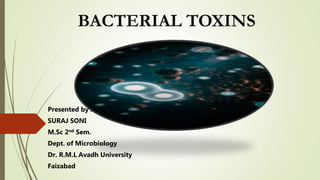
Bacterial toxins ppt (powerpoint presentation) by Suraj soni
- 1. BACTERIAL TOXINS Presented by :- SURAJ SONI M.Sc 2nd Sem. Dept. of Microbiology Dr. R.M.L Avadh University Faizabad
- 2. Toxin : A poisonous substance that is specific product of the metabolic activity of a living organism and is usually very unstable, notably toxic when introduced into the tissues, and typically capable of antibody formation. Bacterial toxin : It is of two types 1. Endotoxin 2. Exotoxin
- 3. Endotoxins Endotoxins are toxic lipopolysaccharides (LPS) found in most Gram negative bacteria. They are structural components of the outer membrane of the Gram negative bacteria. Chemistry and activity of LPS:- The structure LPS consists of three covalently linked subunits. 1. The membrane distal O-specific polysaccharide 2. The membrane proximal core polysaccharide 3. Lipid A
- 4. O-specific polysaccharide is connected to the core polysaccharide. It typically contains galactose, glucose, rhamnose, and mannose as well as one or more dideoxyhexoses, such as abequose, colitose, paratose, or tyvelose. These sugars are connected in four or five membered sequences, which often are branched. The core polysaccharide consists of ketodeoxyoctonate(KDO), various seven carbon sugars (heptoses), glucose, galactose, N-acetylglucosamine. The lipid portion of the LPS called lipid A. The lipid A portion of LPS is responsible for toxicity. Whereas the polysaccharide fraction makes the complex water soluble and immunogenic, but both the lipid and polysaccharide fractions must be delivered as a unit for toxicity.
- 5. Structure of LPS of gram negative bacteria.
- 6. Fatty acid commonly found in lipid A include caproic(C6), lauric(C12), myristic(C14), palmitic(C16), and stearic(C18) acids. Besides its importance in rendering strength to the Gram negative cell, an important biological activity of LPS is its toxicity to animals. Common Gram negative pathogens for humans include species of Salmonella, Shigella, and Escherichia. Toxicity is associated with the LPS layer, in particular lipid A. Some endotoxins cause violent symptoms in humans including gas, diarrhea, and vomiting, and the endotoxins produced by Salmonella and enteropathogenic strains of E. coli transmitted in contaminated foods are classical example of this.
- 7. Exotoxins A protein released extracellularly by a microorganism as it grows that produce immediate damage to the small intestine of the host. These toxins travel from a site of infection and cause damage at distant site. Exotoxins fall into three categories in terms of mechanism : 1. Cytolytic toxins: it work by degrading cytoplasmic membrane integrity, causing lysis. 2. AB toxins: it consist of two subunit. 3. Superantigen toxins: it work by stimulating large number of immune cells, resulting in extensive inflammation and tissue damage.
- 8. Cytotoxins:- The lytic activity of these toxins is most easily observed in assays that use red blood cells (Erythrocytes), toxins are often called hemolysins. Hemolysins also lyse cells other than erythrocytes. Production of hemolysins is demonstrated on a blood agar plate. During growth of the colonies, hemolysins is released and lyses the surrounding red blood cells, releasing hemoglobin and creating a clear area, called a zone of hemolysis, the growing colonies. Example- Streptolysin O, a hemolysin produced by streptococci. Alpha toxin of Clostridium perfringens. Leukocidins by Staphylococcus aureus lyses WBCs.
- 9. Diphtheria Toxin :- The toxin produced by Corynebacterium diphtheriae is an AB toxin. Diphtheria toxin inhibits protein synthesis in eukaryotes. Humans and many other animals are very susceptible, with only a single molecule of toxin sufficient to kill a cell. One component of AB toxin, i.e subunit B specifically binds to a host cell protein. After binding, proteolytic cleavage between subunit B and the remaining portion the protein, subunit A, allow subunit A to move across the host cytoplasmic membrane into the cytoplasm. Subunit A disrupts protein synthesis by blocking transfer of an amino acid from tRNA to growing polypeptide chains. Diphtheria toxins specifically inactivates elongation factor 2 (EF-2).
- 10. Diphtheria toxin is not encoded by the bacterium but instead by a viral gene called tox present in the genome of the lysogenic bacteriophage β. Toxigenic, pathogenic strains of C. diphtheriae are infected with phage β and hence produce the toxin. Nontoxigenic, nonpathogenic strains of C. diphtheriae can be converted to pathogenic strains by infection with phage β, a process called phage conversion. Other examples of AB toxin; the enterotoxin produced by Shigella dysenteriae, called shiga toxin and the shiga like toxin by E. coli, are AB toxin. Botulinum, tetanus, and cholera is also an AB toxin.
- 12. Superantigens:- These are proteins capable of eliciting a very strong response because they activate more T cells than a normal immune response. Superantigens interact directly with TCRs and MHC proteins. They are produced by many viruses and bacteria. Superantigen interaction with TCRs differ from the conventional antigen-TCR binding. Conventional foreign antigens, presented by an MHC protein, bind to a TCR at a defined antigen-binding site. However, superantigens bind to a site on the TCR that is outside the antigen-specific TCR binding site. A superantigen binds to all TCRs with a shared common structure, and many different TCRs share the same structure outside the antigen-binding site. In some cases, superantigens can bind 5-25% of all T cells, whereas less than 0.01% of all available T cells interact with a conventional foreign antigen in a typical immune response. A very common superantigen disease is Staphylococcus aureus food poisoning, by fever, vomiting, and diarrhea. S.aureus also produces the superantigen responsible for Toxic shock syndrome(TSS). Streptococcus pyogens responsible for scarlet fever.
- 13. Picture showing superantigen bind with TCRs and MHC protiens Toxic shock syndrome; individual exhibits “Strawberry tongue”
- 15. Reference:- Brock biology of microorganisms, 14th edition, chapter 2,23, and 24 and page no. 69, 744-753, and 774.